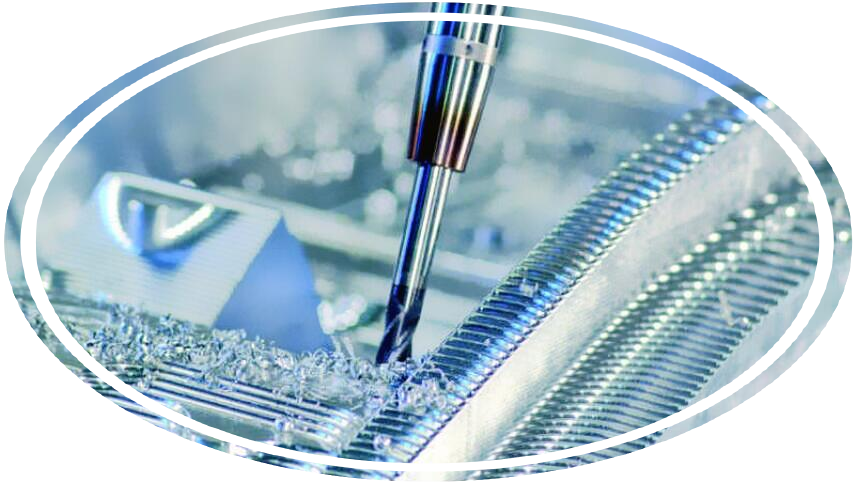
Micro-cutting technology is a fast and low-cost micro parts machining method, and is not limited by the material, the use of CNC machining center can achieve 2D, 2.5D simple features to complex 3D surface parts of the micro machining, through the use of this method to process the micro mold can achieve the purpose of mass production.
With the diversified development of MEMS and micro machinery, the demand for micro-components with different mechanical and electronic properties is becoming more and more urgent. Mmes technology has become one of the fastest growing industries in the world, and industries that require the manufacture of extremely small, high-precision parts, such as biology, medical equipment, optics, and microelectronics (including mobile communications and computer components), are in high demand. However, not every micro-component used in MEMS or micro-machinery can be produced using integrated circuit technology, so new materials and new micro-manufacturing technologies and micro-cutting technologies have been researched and developed.
The Mechanics of Micro-Cutting To fully appreciate the marvel of micro-cutting, let's take a deep dive into its mechanics. At its core, micro-cutting involves two essential elements: the fabrication of micro-tools and the process of material removal.
Micro-cutting, due to the small size of the work-piece, from the strength, stiffness are not allowed to use a larger cutting depth and feed, while to ensure the requirements of the work-piece dimensional accuracy, the final finishing surface cutting layer thickness must be less than its accuracy value, so the cutting amount must be very small. If the cutting depth is sometimes less than the grain diameter of the material, so that the cutting can only be carried out in the grain, then the cutting is equivalent to a discontinuous cutting, the physical substance of the cutting is to cut off the material molecules, atoms, atoms or molecules to remove, so the traditional continuous mechanics based cutting theory is not suitable for micro cutting, so, The research of micro-cutting mechanism needs to adopt different methods from the traditional plastic theory.
Using strain gradient theory, scaling effects and dislocation effects can be predicted, and the results are in agreement with the experiments. The problems of micron indentation, crack tip field, interface crack, filament torsion and thin beam bending have been successfully analyzed in the field of micro mechanics and micro-components, and have begun to be applied in micro-molding research. The study of micro-cutting deformation by strain gradient plasticity theory will be the direction of micro-cutting mechanism research.
Strain gradient plasticity theory is the extension and improvement of the traditional plastic theory, and it is a necessary bridge between classical plastic mechanics theory and atomic simulation. In recent years, many strain gradient plasticity theories have been developed. Typical ones include CS (couple stress) strain gradient plasticity theory, SG (stretch and rotation gradients) strain gradient plasticity theory and MSG (mechanical-based strain) gradient) strain gradient plasticity theory.
In order to improve processing efficiency, the speed of the spindle of the micro-cutting machine tool is very fast. To meet torque requirements, electric spindles and hybrid angular contact bearings are usually used. The table of micro-cutting precision machine tools is generally driven by a linear motor, which can provide greater acceleration. Micro-cutting precision machine tools have good stiffness, small vibration, and are mostly equipped with various sensors and actuators. However, due to its large size and strict control requirements for the surrounding environment, the cost of processing small parts is high. Due to the small machining feature size of micro mechanical products, researchers are trying to develop micro machine tools to process tiny parts. The positioning accuracy of the micro machine tool can reach the nanometer scale, and the processing accuracy is sub-micron.
The use of CNC machining center can achieve 2D, 2.5D simple features to complex 3D surface parts of the micro-machining, through the use of this method to process small molds, can achieve the purpose of mass production
Picture this: You’re crafting a miniature sculpture, but instead of clay and a small knife, you have a chunk of metal and a tool smaller than a human hair. That's micro-tool fabrication for you! These tiny tools are usually made from hard materials like diamond or tungsten carbide, promising durability and precision.
Imagine you’re peeling an apple, but on a much, much smaller scale. That's the essence of the material removal process in micro-cutting. The micro-tool chips away material layer by layer, shaping it into the desired minuscule form. It's all about control, finesse, and, most importantly, patience.
Now that you have an idea of how micro-cutting works, let's see where this revolutionary technique is applied.
Imagine a world where surgeons use instruments as thin as a strand of hair for procedures. That's no longer science fiction, thanks to micro-cutting. This technique enables the creation of miniature surgical tools, enhancing precision and minimizing patient trauma during surgery.
Ever opened up a smartphone or a laptop and wondered how those tiny electronic components were made? Well, micro-cutting plays a massive role here. It allows for the manufacture of microscopic, complex components necessary for modern electronics to function.
Micro-cutting is not just earth-bound. It has taken flight in the aerospace industry too! Minute components in space exploration devices or commercial aircraft, crafted with the help of micro-cutting, ensure performance, safety, and reliability.
Micro-cutting isn’t just about making small things. It’s about achieving a level of precision, efficiency, and quality that other techniques can't match. And in doing so, it enables innovations across various industries.
However, micro-cutting is not without its challenges. But with every problem comes a solution, right?.
One of the significant issues in micro-cutting is tool wear and breakage. But innovative materials like pcd ,diamond and advanced cooling techniques help extend the life of these tiny tools.
Another hurdle is material deformation during the cutting process. The solution? Use of precise force control and advanced material handling techniques..
The challenges seem daunting, but the industry is finding ways to overcome them, paving the way for better, more efficient micro-cutting processes.
The Future of Micro-Cutting
Micro-cutting is here to stay. With ongoing research and technological advances, the precision and applications of micro-cutting will only grow, fostering innovation in various industries.
(1) Basic research on micro-cutting applications: including research on key technologies of micro-parts cutting equipment, mainly studying high-speed spindle system, positioning, motion and control technology of precision workbench, and composite micro-cutting equipment and technology; Research on the material and fabrication technology of micro cutting tool; Micro-cutting tool, work-piece quick clamping, testing and micro-cutting process monitoring technology.
(2) Research on micro-cutting mechanism: mainly study the non-uniform deformation field of micro-cutting under heat-force coupling stress, study the constitutive equation of work piece material under micro-scale, analyze the influence of size effect, non-uniform strain and dislocation of micro-cutting deformation zone on shear deformation stress and shear deformation energy; The influence of minimum cutting thickness on chip shape, machined surface formation, cutting force, cutting temperature, and the influence of micro-structure of work-piece material on surface roughness and sub-surface damage were studied, and the theory and technology system of micro-cutting were established. The multi-scale micro-cutting simulation technology is studied to lay the application foundation of micro-cutting technology.
(3) Micro-cutting technology research: including a variety of new materials such as steel, titanium alloy, stainless steel, aluminum alloy, ceramics and other non-metallic materials and a variety of composite materials micro-cutting technology, micro-cutting CAD CAM technology.
(4) Research on the economy and reliability of micro-cutting technology.
Contact: Nina Qiao
Phone: 8613526572721
E-mail: cutting@zy-superhardtools.com
Whatsapp:8613526572721
Add: AUX Industry,Zhengzhou City,Henan Province,China
We chat
